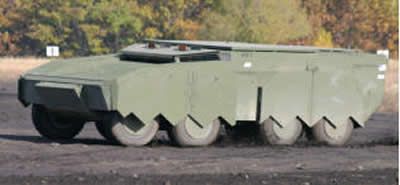New unmanned vehicles are being proposed to carry heavy cargo mission, such as tanks, armored vehicles and supply logistics over long distances, as well as from ship to shore hauling heavy vehicles and outsized cargo loads. Two concepts were unveiled at AUVSI 07 – the Hybrid Unmanned Air Vehicle (HUAV), developed by Lockheed Martin, and the T-Craft, designed by General Dynamics.

Combining buoyancy and aerodynamic lift, HUAV is creating an aircraft capable of carrying payloads of up to 2,500 – 12,000 pounds to an altitude of 20,000 ft, maintaining long persistence over the target area, at costs significantly lower than other manned or unmanned platforms. While the 250 foot long HUAV is designed for long persistence, cruising slowly at about 20 knots, it will also be able to move from one location to another at a top speed of 60 knots. HUAV will be ideally suited for long dwell missions (over 7 days without refueling) over low-threat environments. The large volume available for the payload enables the integration of sensors having very large aperture (up to 100 ft long, 20 ft wide). According to Lockheed Martin, the HUAV could be fully developed within 24 – 30 months and, if sufficiently funded, could fly by 2010.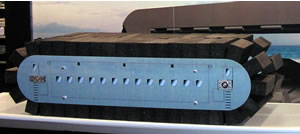
Lockheed Martin is also planning a much larger version of the hybrid aircraft, capable of delivering heavy cargo over a range of 2,000 miles. The hybrid airship/aircraft will be constructed from high-strength fabrics providing buoyancy and aerodynamic lift. Its large size will accommodate outsized cargo, or 10 – 14 standard pallets weighing up to 50 tons. It will be equipped with four pusher thrust vectoring propellers and a landing system utilizing four air cushions enabling the airship to be airfield independent, land and takeoff from short unprepared surfaces. The crew controlling the hybrid aircraft will use on board weather monitoring and route planning to establish the best, safest flight route for the aircraft.
Completely different concept is pursued by General Dynamics, with the T-Craft Captive Air Amphibious Transporter (CAAT). The program addresses the Office of Naval Research (ONR) Seabasing Innovative Naval Prototype program, with an unmanned floating vessel capable of transverse sand bar and mud flats, offering the US Marines Corps with ‘feet dry on the beach” capability. CAAT will be able to carry twice the load of current amphibious landing crafts (LCAC), deployed from flat bed vessels such as LHDs and future Catamaran landing support ships. At AUVSI CAAT was displayed wit a load of two M-1 tanks and two HMMWVs. The autonomously controlled vessels will be propelled by linked buoyant cells forming a track-like propulsion system. Each vessel will have two tracks enabling forward and backward motion and steering by differential movement. The CAAT concept is currently under evaluation and, if funded, could become reality within a few years.
Topics covered in AUVSI 2007 review:
- Unmanned Systems – Flight and Ground Demonstration 2007
- UAV systems, including Combat UAVs
- Mini, Micro and Expendable UAV Systems
- The future USMC Tier II program
- High Altitude Long Endurance (HALE) Platforms
- Unmanned Transport Vehicles
- Mission Control Systems & Applications
- Advanced payloads for unmanned Systems
- UGVs and Controls Systems





 Until the early 2000s, only few manned platforms could soar to such heights. One of the first to explore these altitude was the Lockheed U-2 strategic reconnaissance aircraft, designed in the late 1950s. A decade later, the SR-71A strategic reconnaissance aircraft, unofficially known as the “Blackbird,” was used as long-range, advanced, strategic reconnaissance aircraft. The first flight took place on Dec. 22, 1964. Then the ‘Blackbird’ served for 22 years providing strategic reconnaissance missions and was retired in 1990 only to return five years later to fill a critical recce gap. Throughout its nearly 24-year career, the SR-71 remained the world’s fastest and highest-flying operational aircraft. The SR-71 flew at more than three times the speed of sound (Mach 3) at altitudes in excess of 80,000 feet (approximately 15 miles high).
Until the early 2000s, only few manned platforms could soar to such heights. One of the first to explore these altitude was the Lockheed U-2 strategic reconnaissance aircraft, designed in the late 1950s. A decade later, the SR-71A strategic reconnaissance aircraft, unofficially known as the “Blackbird,” was used as long-range, advanced, strategic reconnaissance aircraft. The first flight took place on Dec. 22, 1964. Then the ‘Blackbird’ served for 22 years providing strategic reconnaissance missions and was retired in 1990 only to return five years later to fill a critical recce gap. Throughout its nearly 24-year career, the SR-71 remained the world’s fastest and highest-flying operational aircraft. The SR-71 flew at more than three times the speed of sound (Mach 3) at altitudes in excess of 80,000 feet (approximately 15 miles high). Global Hawk may be dominating the high altitudes today, but in the near future, it will have to share those heights with more unmanned platforms. One such system is the
Global Hawk may be dominating the high altitudes today, but in the near future, it will have to share those heights with more unmanned platforms. One such system is the Another system under development by Aurora Flight Science and Boeing is the the Orion,
Another system under development by Aurora Flight Science and Boeing is the the Orion,  Flying at the edge of space in the high stratosphere, a future unmanned aircraft could one day carry weapons or other payloads anywhere in the world within few hours, or deploy cargo to lower space orbit, responding within minutes to urgent mission requirements. These high flyers will be designed to carry our fast strikes deep into enemy territory, anywhere in the world. Such a project known as
Flying at the edge of space in the high stratosphere, a future unmanned aircraft could one day carry weapons or other payloads anywhere in the world within few hours, or deploy cargo to lower space orbit, responding within minutes to urgent mission requirements. These high flyers will be designed to carry our fast strikes deep into enemy territory, anywhere in the world. Such a project known as 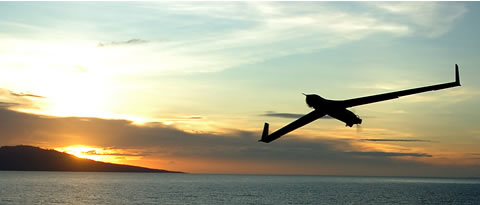
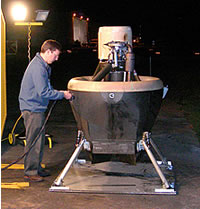
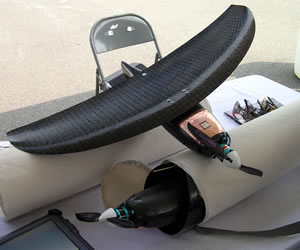
 To improve mission range, persistence and raid response, some UAS are designed to be air-insertable. Since such missions could be ‘one way’ only, these UAVs are designed to be low-cost, optionally expendable systems. Among these are the the
To improve mission range, persistence and raid response, some UAS are designed to be air-insertable. Since such missions could be ‘one way’ only, these UAVs are designed to be low-cost, optionally expendable systems. Among these are the the 
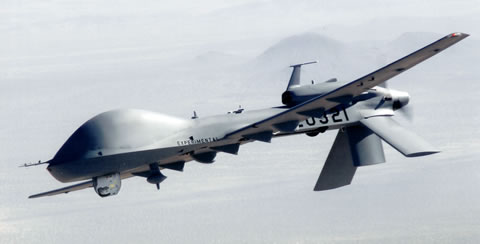
 more mature. However, just prior to the event, Tier II changed direction, somewhat reshuffling the cards for many participants. AUVSI provided the stage for several companies to display relevant technologies related to the tactical Tier II program. These included the New
more mature. However, just prior to the event, Tier II changed direction, somewhat reshuffling the cards for many participants. AUVSI provided the stage for several companies to display relevant technologies related to the tactical Tier II program. These included the New  Other Tier II candidates at the show were the
Other Tier II candidates at the show were the  US Marines. Smaller systems, such as the the new
US Marines. Smaller systems, such as the the new  They will be used for fire support, armed scout and ISR missions directly supporting maneuver forces. They are designed augmenting or replacing manned helicopter gunships or manned close air support. These Vertical Take-Off and Landing (VTOL) Combat UAVs are expected to follow fielding of FireScout later in the next decade. Such futuristic designs are already under development, including the
They will be used for fire support, armed scout and ISR missions directly supporting maneuver forces. They are designed augmenting or replacing manned helicopter gunships or manned close air support. These Vertical Take-Off and Landing (VTOL) Combat UAVs are expected to follow fielding of FireScout later in the next decade. Such futuristic designs are already under development, including the 

 The “Unmanned Systems North America” exhibition and conference was held in August 2007 by the
The “Unmanned Systems North America” exhibition and conference was held in August 2007 by the 
 Israel Aerospace Industries’ MALAT group actually demonstrated the simultaneous launch, flight and recovery of two
Israel Aerospace Industries’ MALAT group actually demonstrated the simultaneous launch, flight and recovery of two

 Different unmanned systems participated in a mock battle scenario, involving a team of marines, engaging insurgents in a simulated urban area. First in line was the
Different unmanned systems participated in a mock battle scenario, involving a team of marines, engaging insurgents in a simulated urban area. First in line was the  robotic
robotic 
 Back at the convention center, the exhibition provided professionals with a vision of where the industry is heading, highlighting exotic futuristic designs, advanced materials and new sensors.
Back at the convention center, the exhibition provided professionals with a vision of where the industry is heading, highlighting exotic futuristic designs, advanced materials and new sensors. surveillance aircraft in the next decade. The Navy considers three alternatives representing totally different solutions, based on the
surveillance aircraft in the next decade. The Navy considers three alternatives representing totally different solutions, based on the 